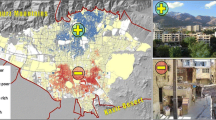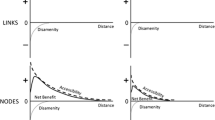Abstract
The author examines in this study the relationship between public investment in METRO and property values in several neighborhoods in Washington, D.C., in order to determine if public investment in heavy rail transit systems increases residential property values. In order to examine this relationship, a hedonic price equation which included a dummy independent variable was estimated. Analysis of the data revealed a significant direct relationship between the opening of METRO and residential property values. Therefore, it can be concluded that public investment in METRO caused property values to increase around station site areas.
Similar content being viewed by others
References
Alonso, William.Location and Land Use: Toward a General Theory of Land Rent. Cambridge, MA: Harvard University Press, 1964.
Arlington County Planning Division. “Development of the Metro Corridors: Existing Zoning, Approved Development for the Years 1960 to Present,” prepared for the Department of Community Affairs, Planning, Housing, and Community Development Division, Arlington, VA, 1983.
Boyce, David, et al. Impact of Rapid Transit on Urban Residential Property Values and Land Development. Philadelphia: University of Pennsylvania, 1972.
Brigham, E. “The Determinants of Residential Land Values.”Land Economics 41 (1965): 325–334.
Cox, D.R., and G.E. Box. “An Analysis of Transformation.”Journal of The Royal Statistical Society Series B (1964): 211–284.
Damm, David, Steven R. Lerman, Eva Lerner-Lam, andJeffrey Young. “Response of Urban Real Estate Values in the Anticipation of the Washington, Metro.”Journal of Transport Economics and Policy 14 (1980): 315–334.
Dewees, Donald. “The Impact of Urban Transportation Investment and Land Values.” University of Toronto-York University Joint Program in Transportation Research, Report Number 11, 1976.
Grass, Gail. “A Study to Determine if Public Investment in Rapid Transit Station Sites in Washington, D.C., Displaces Minorities,” Ph.D. diss., Howard University, 1989.
Green, Rodney D. “Joint Development Around Rapid Transit Station Sites,” prepared for the U.S. Department of Transportation, Washington, D.C., August 1986.
Grether, D.M., andPeter Miezkowski. “Determinants of Real Estate Values.”Journal of Urban Economics 1 (1974): 127–46.
Haig, R.M. “Towards an Understanding of the Metropolis.”Quarterly Journal of Economics 2 (1926): 179–208.
Hurd, R.M. Principles of City Land Values. New York: The Record and Guide, 1903.
Muth, R.F. Cities and Housing. Chicago, Illinois: Chicago University Press, 1969.
Polinsky, A.M. “Amenities and Property values in a Model of Urban Areas.”Review of Economics and Statistics (February 1976): 119–130.
Von Thunen, Johan.Der Isolierte staat in Beziehung auf Landwirschaft and nationale Konomie. Munich: Pflaum, 1863.
Wolf, Marianne McGary. “Public Investment in Transportation, Expected Transportation Costs, and The Urban Housing Market.” Ph.D. diss., John Hopkins University, 1979.
Author information
Authors and Affiliations
Rights and permissions
About this article
Cite this article
Grass, R.G. The estimation of residential property values around transit station sites in Washington, D.C.. J Econ Finan 16, 139–146 (1992). https://doi.org/10.1007/BF02920114
Issue Date:
DOI: https://doi.org/10.1007/BF02920114




